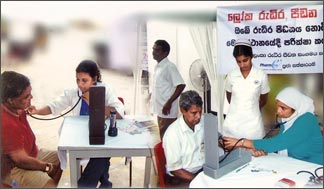Health Watch
Healthy justice!
Nadira GUNATILLEKE
If you are a regular newspaper reader, you must remember some of the
tragic incidents reported in the Daily News and all the other newspapers
some time back. In one instance a doctor pushed an innocent young female
patient from the fifth floor of a state hospital and killed her.
|

Justice should be served |
Few months ago there was another news item where a doctor raped a
pregnant mother, warded at Sri Jayawardenepura Hospital for childbirth.
Do you still remember them? I do remember them because I reported them
for the Daily News! Maybe there are many people who remember those
incidents and wonder what happened to those culprits.
Verdict
The MBBS doctor who pushed one of his female patients from the fifth
floor of a state hospital is now in remand prison. The case is still
going on. The verdict to be given. The doctor who raped a pregnant
mother warded at a state hospital for childbirth is now interdicted, not
dismissed! But these are not the only cases reported from our health
sector in the past and definitely these are not going to be the last
cases.
|

Doctors are to save not to kill |
Therefore, something has to be done for the protection of patients
because the so called watch dog (media) is being silenced by some type
of force.
There are many cases of medical negligence that take place in almost
all private hospitals in Sri Lanka often, but non of them come into the
light or report it to the media. There are very important questions to
ask in this regard. Are there incidents of medical negligence that
happen in private hospitals in Sri Lanka?
No evidence
The answer is yes. If you ask this questions from yourself! Maybe you
still remember how you suffered even after paying a large amount of
money to obtain their service. Then why are such incidents not reported
to the media?
This question has to be asked because whenever something goes wrong
in a state hospital it is media which start a ‘crusade’ to tarnish the
health service while earning good money by selling the story. But it is
not so when it comes to private hospitals and to certain `holy doctors’
who appear in our society time to time and ‘cure’ people or send them
directly to heaven !
As a health journalist, I can answer this to question myself. You may
not believe, there is a private hospital mafia in Sri Lanka. It cannot
be seen openly and no evidence at all. But it is there. I got my first
experience of this mafia when I had to report something negative about
the private hospitals.
I received the information from the Health Ministry. I reported it in
my newspaper. After reading the news item, this private hospital `mafia’
contacted me and forced me to write the opposite of the same story which
I did not do. Another incident took place when I reported about an
`operation’ that was preventing poor people getting quality drugs at a
low price. It seems some `elements’ are much more powerful than anybody
else.
General knowledge
You have a big responsibility as a patient when it comes to ensuring
that you get the best care. The first requirement is a good general
knowledge.
You have to know simple things such as there are small and big
cannulas available in all hospitals for the use of babies and adults.
If a nurse comes with a huge cannula to give an injection/saline to
your baby, you should ask her to use a baby cannula. If she says no, you
have to ask why she cannot follow the relevant procedure. You have to do
this especially when you pay money and obtain services from the private
sector.
Medical tests
It is same when it comes to medical tests. Some medical tests require
certain preparations. For an example if you are warded at a hospital to
obtain a abdominal ultra sound scan, you need to drink adequate water to
fill your bladder and have to wait without passing urine.
But according to my own experiences, in certain private hospitals,
this preparation part is completely ignored (especially when you are
warded with no serious illness or symptoms), and the patients get wrong
medical reports.
This can put their lives in danger. The patient pay thousands of
rupees for a useless medical report which does not contain the actual
information of his/her condition! Do not hesitate to ask questions when
you do not know what is going on and when you suspect something.
Learn the names and appearance of simple drugs such as different
types of antibiotics, pain killers and other medications. Once my father
saved my life when I was given Inderal (a medication prescribed for
heart aliments) tablets instead of Incidal tablets (a tablet prescribe
for skin diseases).
I was just a 7 years old kid and my father compared the name of the
tablet and the name in prescription and found out the fatal error made
by the unqualified pharmacist. My father used Inderal.
Do not place your entire trust on the hospital staffs, medical
equipment and even lab reports.
They can go wrong at any time. Take a part of the responsibility to
your shoulders. After all it is your life. Memorize the history of your
disease and describe it to the doctor in detail in advance.
What you feel is more important when it comes to your health. You
cannot diagnose your own disease but doctors or nurses cannot ignore
what you feel inside your body, especially when it is difficult to
diagnose your disease.
Health promotion for a healthier tomorrow
The authorship of our own health and well-being is with us; Lord
Buddha had taught. Transforming this authorship from our traditional
health care provider to the individual has proved to be a promising
mechanism in resisting the obstacles and achieving optimal well being.
This simple but important fact is the core theme in health promotion.
In the past few decades, factors determining our well-being were
notoriously inept and they continue to be so.
|

Suicides increasing to stress and depression |
It is primitive to believe in health as a passive concept that is
mainly dependent on the health care provider. Health should be viewed as
a positive concept emphasizing social and personal resources, as well as
physical capacities of an individual.
In the recent past, we have begun hearing about an increase in
premature deaths due to non-communicable diseases, in addition to
chronically escalating violence, accidents and suicide.
True, at present the life span of a Sri Lankan individual is
considered relatively long. However, the added years are lived in poor
health causing reduced quality of life to the victim, additional burden
to the caregivers, and cost to the health system.
The threat to lives of the younger generation by the above mentioned
health issues is an immediate matter of concern. Many of these health
issues pose a significant bearing on the productivity of the nation
through reducing quality of life on a long-term basis. The major
non-communicable diseases are cardiovascular diseases, cancer and
diabetes.
These diseases are attributable to the highest number of deaths in
our South East Asian Region. The risk factors leading to these diseases
are mainly a cluster of life style factors, for example, major ones
being smoking, alcohol consumption, physical inactivity and unhealthy
dietary patterns. These can be readily controlled. Projections have
shown to be that these major diseases will continue to be the main
health challenges in the years to come.
Although the technological revolution in the medical field is
progressing, somewhere we are failing to control the epidemics of
communicable as well as the above-mentioned non-communicable diseases,
injury and suicide. Government efforts are massive in spending both
manpower and money on ill health. So where is the slip-up?
We have failed to empower our communities in making them responsible
for their own health. Traditional health systems continue to make
decisions on behalf of the patients, oversee their needs and we still
practice a conventional top down approach.
In this scenario, health promotion has appeared as a trustworthy
reconsideration to our health systems. The Ottawa Charter (1986) defines
health promotion as: “the process of enabling people to increase control
over, and to improve, their health..”
The strategy of health promotion has several guiding principles, one
of which is understanding that health is affected not only by genes, but
also by the individual’s lifestyle, the community’s quality of health
care, and social, environmental, economic as well as political factors.
Acting on a particular area or working on a sustainable change based
on the best available data and evidence, and working to reduce social
injustice against every individual, family and community so that they
can fully benefit from a health promoting society, are another two
general principles of this philosophy.
Furthermore, encouraging community participation to enable
individuals to make individual decisions on their health, using
information, skill development, support, advocacy and structural change
strategies so that people are not wholly reliant on the health care
providers is a main principal of health promotion.
In other words, health promotion articulates empowerment as a major
health outcome or the final step of the behavior change. Additionally of
course, it is necessary that health promotion is initiated in
collaboration with a broad range of sectors; not simply the health
sector and with those that do not have a distinct health focus.
This action will hopefully deliver quality health promotion programs
and will reduce duplication or fragmentation of the effort. Through the
above-mentioned frame or principles, it is hoped that health promotion
flourishes as a quality and accepted resource in maintaining population
wellbeing.
In this background a question arises as, what is the role of health
care providers in health promotion? The answer is reflected in three
bold words; enabling, mediating and advocating. That is, health care
providers should enable the individuals and communities to have control
over their own health through provision of information and skill
development.
They should be capable of mediating between different sectors and
then advocating on the importance of health promotion to decision makers
and communities. However, the present health professionals are
incompetent in those three roles. If we are anticipating success in the
field of health promotion, the education curricula of health
professionals must be appropriately reoriented.
Considering the promising ideologies of health promotion, all the
same it is slow to progress. There are several reasons for this matter.
Firstly, our traditional health systems still adhere to the more
conventional health approaches whilst barring the communities from
experiencing control over decisions that influence their own well-being.
Resultantly, communities themselves feel more comfortable having
health care providers making decisions on their health. In short, our
communities are not adequately empowered to independently control their
own health.
Not understanding the importance of working together with other
sectors, but working in isolation inevitably results in losing potential
benefits for the communities. Mediating skills of health professionals
decide on the successfulness of such collaborations.
Awareness of decision makers on health promotion is weak. So it is of
utmost importance of advocating them on this matter on behalf of
communities.
Advocacy is to gain political commitment, policy support and the
desired social acceptance, with the aim to protect vulnerable people and
empower whose requirements and views should be listened to.
Another issue is that although the concept of health promotion
encourages the use of best available evidence based practices, in our
setup the research practice gap is huge.
Usually evidence-based information from foreign cultures, some in
which the socio-cultural adaptability of is questionable, are
incorporated. It is mandatory to involve the policy makers at initial
stages of research in order to facilitate the knowledge transfer
smoothly and timely.
Moreover, the value of partnership building cannot be underestimated
in health promotion. Here too, the health sector lags behind. Not to
mention in the inter-sectoral partnership, within the health system
private public partnership is also very weak.
Health programs are rarely designed based on the needs of its
communities. However, health promotion programs maintain sustainability
through considering the specific needs of the local communities and
making sure that the latter is involved in every stage of the program
design, implementation and evaluation.
The above failures of the local health situation are not the only
reasons to reconsidering a new strategy; that is, in the form of health
promotion. It is a highly cost effective measure and is the ideal
solution to our escalating health expenditure.
Our well-developed existing public health network will be a reliable
channel through which this concept can be disseminated to health and
non-health sectors and local communities.
Furthermore, strong sustainability of results is assured since the
major activists in this approach are the empowered individuals. And it
is reassuring that different approaches of health promotion are
adaptable to our existing health systems without much of an
infrastructure modification or expenditure, simply with the people’s
dedication.
What’s more, settings approach can be incorporated to any community
or institution while life course approach of health promotion can be
practiced through mainstreaming the health promotion concept in to an
existing health program, such as Maternal and Child Health program.
Placing the empowered communities as the main pillar of this process,
building partnerships with a broad range of sectors, implementing a
variety of interventions designed by and with people but not on people,
health promotion will lead to the desired shift in population well
being, a sustainable one.
Dr. Sujatha Liyanage, Health Education Bureau
Tummy Ache?
Blame it on Biodiversity Loss
Mallika Naguran
Thanks to a kind of frog that can no longer be found, millions of
people suffering from stomach ulcers (peptic ulcers) have lost a chance
to heal better.
The southern gastric brooding frog (Rheobatrachus) discovered in the
Australian rainforests in the 1980s intrigued scientists with its
ability to raise its young in the stomach where enzymes and acids could
have digested them instead.
|

Photo courtesy of United Nations Environment Program (UNEP)
and World Society for the Protection of Animals (WSPA). |
This amazing fact led to preliminary studies that the baby frogs
produced substances that inhibited acid and enzyme secretions the
gastric tract, or stomach.
As the frog has been extinct, the research stopped prematurely. “The
valuable medical secrets they held are now gone forever,” key authors of
the newly released book Sustaining Life: How Human Health Depends on
Biodiversity Eric Chivian and Aaron Bernstein said. New treatments for
thinning bone disease, kidney failure and cancer plus a new generation
of antibiotics may all stand to be lost unless the world acts to reverse
the alarming rate of biodiversity loss, the book argues.
It also comprehensively explores the medicinal relevance of diverse
species such as bears, cone snails, sharks, horseshoe crabs and
gymnosperms.
Since time immemorial, plants and animals have provided solutions to
many of mankind’s quests for health by learning more about how they live
and stay alive in spite of unusual factors.
It has now unfortunately become increasingly difficult for research
in natural medicinal sources due to the critical reduction of biological
diversity.
As animals become extinct due to climate change and the destruction
of their natural habitats such as rainforests (both human influences)
the chances to study evolution and biology to better understand our
planet become difficult.
The head of United Nations Environment Program Achim Steiner
describes the rate of biodiversity loss as reaching ‘dramatic
proportions’.
“Human activity, environmental impacts, climate change and loss of
biodiversity have led to the loss of important ecosystems. It’s a
tragedy that the world does not understand the value of biodiversity,”
Steinerhe told media.
Who should sit up and take notice of biodiversity loss?
“It is no longer the luxury of ecologists or naturalists to care
about preserving biodiversity but society as well,” Achim Steiner said
adding that pharmaceutical companies greatly depend on nature, not just
chemicals, to treating society’s health and well-being.
World Hypertension Day
The International Society of Hypertension declared May 17, as the
World Hypertension Day. This is now an annual event. In this institution
we have been having a Public Awareness Program for the third year in
succession.
|

Kidney, Diabetes Hypertension and Cardiovascular Centre |
Of the 6 billion people in the world nearly 1.2 billion people suffer
from Hypertension. In the USA (JNC7) guidelines anyone with BP>120/80 to
139/89 would be in the ‘Pre-hypertension’ category and BP>140/90 mm
would be declared Hypertensions. Nearly 20 percent of global population
are Hypertensives and more with pre-hypertension.
High Blood Pressure is associated with obesity, hypercholesterolemia,
diabetes, Metabolic Syndrome and family history of hypertension.
Expected complications in the untreated include.
Heart failure, Kidney failure and Angina. The course is usually
primarily undetectable (essential hypertension) and sometimes secondary
to kidney disease, endocrines disease or renorascular disease or
associated with drugs.
Prevention is better than cure Lifestyle modification is mandatory
viz reduce weight, reduce salt, smoking and strees.
A new Centre viz Kidney, Diabetes Hypertension and Cardiovascular
Centre (KDHC) is promoting prevention and health promotion and early
detection of these connected illnesses with common overlapping factors.
They advice avoiding “9S” factors. |



